The Beatles in 1967
Buy Sgt. Pepper’s Lonely Hearts Club Band
Buy Magical Mystery Tour
 There has never been (nor probably will ever be) a year in which a single band produced so much quality material as The Beatles did during the year 1967. In order to properly pay tribute, we at Classic Rock Review have put together our largest article ever. This includes extensive reviews of both the Sgt. Pepper’s Lonely Hearts Club Band and Magical Mystery Tour albums along with a look at all the rest of the band’s output from that year which included recordings for future projects, several promotional videos, a live television special, and their third dedicated film. Unlike our normal album reviews, we look at everything in a strictly chronological order, delving into everything as it came about in sequence. This method works best because so many projects and elements overlapped during the year and only found their proper, permanent place as history unfolded.
There has never been (nor probably will ever be) a year in which a single band produced so much quality material as The Beatles did during the year 1967. In order to properly pay tribute, we at Classic Rock Review have put together our largest article ever. This includes extensive reviews of both the Sgt. Pepper’s Lonely Hearts Club Band and Magical Mystery Tour albums along with a look at all the rest of the band’s output from that year which included recordings for future projects, several promotional videos, a live television special, and their third dedicated film. Unlike our normal album reviews, we look at everything in a strictly chronological order, delving into everything as it came about in sequence. This method works best because so many projects and elements overlapped during the year and only found their proper, permanent place as history unfolded.
Before diving into 1967, it is important to provide the context of the Beatles’ career in 1966. By that time the Beatles had conquered the musical world like no other rock act before, but still things were starting to unravel. There was major controversy over John Lennon‘s “more popular than Jesus” comments, causing the members to need heavy guards everywhere they went and they had nearly lost their lives in the Philippines after offending dictator Ferdinand Marcos. Further, the band was getting tired of the constant touring and frenzied fans and decided to halt touring altogether by the end of the summer of ’66. Despite putting out the brilliant album Revolver, it was under-appreciated in its day and many wondered whether the band was past its peak. All four members decided to take an extended break and decide what to do next. George Harrison took his first trip to India while Lennon starred in the major motion picture How I Won the War. On his way home from a vacation in America, Paul McCartney came up with the idea of doing an album from the perspective of an alter-ego band.
 The band reconvened at Abbey Road Studios on November 24, 1966 (Thanksgiving in the USA, but just a normal Thursday in England) to start their new album. That night they recorded one song, a simple folk song by Lennon called “Strawberry Fields Forever”. But ultimately, this song would be anything but simple as it took a total of 45 hours to record, and this initial version of the song would not even be used. A second version was started at the end of November, this time featuring a mellotron intro by McCartney. The instrument had just been introduced to the band by Mike Pinder of the Moody Blues (who at the time was working at the instrument’s manufacturing factory) and “Strawberry Fields” would become the first song by a major act to use the instrument. It gave this version of the song a surreal element and atmosphere. Still, Lennon thought he could do more with the song and a third distinct version, scored by producer George Martin, including brass, strings, backwards masking, and complex rhythm section led by Ringo Starr and “about 9 or 10 other players.” When Lennon couldn’t decide if he wanted to use the second or third version of the song, the true magic took place. Martin fused the two together, even though version 3 was at a faster tempo and in a higher key, by using two tape machines varying the speed of one. The result is a production masterpiece which blazed the path for the upcoming Sgt. Pepper album.
The band reconvened at Abbey Road Studios on November 24, 1966 (Thanksgiving in the USA, but just a normal Thursday in England) to start their new album. That night they recorded one song, a simple folk song by Lennon called “Strawberry Fields Forever”. But ultimately, this song would be anything but simple as it took a total of 45 hours to record, and this initial version of the song would not even be used. A second version was started at the end of November, this time featuring a mellotron intro by McCartney. The instrument had just been introduced to the band by Mike Pinder of the Moody Blues (who at the time was working at the instrument’s manufacturing factory) and “Strawberry Fields” would become the first song by a major act to use the instrument. It gave this version of the song a surreal element and atmosphere. Still, Lennon thought he could do more with the song and a third distinct version, scored by producer George Martin, including brass, strings, backwards masking, and complex rhythm section led by Ringo Starr and “about 9 or 10 other players.” When Lennon couldn’t decide if he wanted to use the second or third version of the song, the true magic took place. Martin fused the two together, even though version 3 was at a faster tempo and in a higher key, by using two tape machines varying the speed of one. The result is a production masterpiece which blazed the path for the upcoming Sgt. Pepper album.
Ironically, “Strawberry Fields Forever” would not be included on the Sgt. Pepper’s album. It was released as a “double A” single along with McCartney’s companion piece, “Penny Lane”, at the urging of manager Brian Epstein who wanted a song on the charts. Both songs shared the theme of nostalgia for their early years in Liverpool and both referred to actual locations familiar to all of the Beatles. Although possessing many of the same surreal elements, “Penny Lane” is more sing-songy, like a children’s ballad. It takes a typical suburban scene and turns into something dreamier, like a parade of life. The song has a basic piano melody overlaid by several brass elements and a distinctive piccolo trumpet lead by Dave Mason, who McCartney saw perform on television and commissioned for this song. Although Martin has stated that he believes “Penny Lane”/”Strawberry Fields Forever” is the greatest single ever released by the group, it peaked at #2 on the UK charts.
The earliest recording to actually end up on Sgt. Pepper’s Lonely Hearts Club Band was a vaudevillian number called “When I’m Sixty-Four”, which was recorded during the same sessions as “Strawberry Fields Forever” and “Penny Lane”. Written by McCartney when he was only 16 (about 8 years earlier), the song includes a clarinet trio and sounds like it needs a companion, choreographed stage dance routine to go with it. It was recorded as homage to Paul’s father James McCartney, who actually had turned 64 earlier in 1966.
In early 1967, the Beatles were considering releasing a companion film with the Sgt. Pepper’s album, and recorded a lot of footage of their massive sessions for the song “A Day In the Life” in January and February. The song would be the final track on the album and its crowning jewel as it fused separate compositions by Lennon and McCartney into a singular masterpiece. It starts with Lennon’s folk ballad based on contemporary newspaper articles, accompanied by a strummed acoustic guitar, a bouncy, staccato piano, and great drum fills by Starr. After the initial recordings, Lennon felt like the song needed something more in the middle and McCartney had a short, happy-go-lucky song about his youth which was added. Unsure of how to connect the sections, 24 bars of “empty space” was left on either side of the middle section with assistant engineer Mal Evans counting out the bars on top of a simple, repeating piano. This section was later “filled in” with a building, “orgasmic” orchestral passage, conducted by McCartney and Martin, using 40 players which were later quadriple-tracked to give the effect of an orchestra of 160. The result is perhaps the best Beatles composition ever, ending with the most famous chord in rock history, a single strike played by Lennon, McCartney, Starr, and Martin simultaneously on four separate pianos and sustained four over a minute to finish the song and the album.
Along with “A Day In the Life”, Lennon and McCartney fully collaborated with the duet “She’s Leaving Home”, after reading a newspaper story about a young girl who’d left home and, at the time, was not again found (until many year later). With Martin unavailable to do the score, McCartney enlisted Mike Leander to do the orchestration, including a harp was played by Sheila Bromberg, who became the first female musician to appear on a Beatles record. The song would become one of the last true collaborations by Lennon and McCartney, who constantly worked together during the early years but would each maintain more solo control over future Beatles compositions.
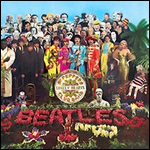 The title song to Sgt. Pepper’s Lonely Hearts Club Band, written by McCartney, is an entertaining albeit tacky song which fits in with the overall image of the album, right down to the cover art which included a montage of of the Beatles’ “heroes” on designed by artist Peter Blake. The song itself has a strong rock presence with a super electric guitar tied together beautifully by a great rock vocal by McCartney, interspersed by many production elements including French horns and audience sounds. The song is reprised later, as a “closing” message just prior to “A Day In the Life”. The opening song segues into “With a Little Help From My Friends”, an entertaining number with a double meaning written by McCartney for Ringo Starr to sing.
The title song to Sgt. Pepper’s Lonely Hearts Club Band, written by McCartney, is an entertaining albeit tacky song which fits in with the overall image of the album, right down to the cover art which included a montage of of the Beatles’ “heroes” on designed by artist Peter Blake. The song itself has a strong rock presence with a super electric guitar tied together beautifully by a great rock vocal by McCartney, interspersed by many production elements including French horns and audience sounds. The song is reprised later, as a “closing” message just prior to “A Day In the Life”. The opening song segues into “With a Little Help From My Friends”, an entertaining number with a double meaning written by McCartney for Ringo Starr to sing.
McCartney also wrote several other upbeat rock songs for the album including “Lovely Rita”, a literal song about a female traffic warden featuring a piano solo by Martin and “Getting Better”, an optimistic creed featuring some excellent instrumentation. Lennon plays a distinct, choppy guitar, while Harrison adds an Indian tambura part and all Beatles sing fine harmonies throughout. “Fixing a Hole” is a more moderate pop song led by Martin’s harpsichord and Harrison’s double-tracked guitar riffs. McCartney said he wrote the song about the the fans who hung around outside his home day and night.
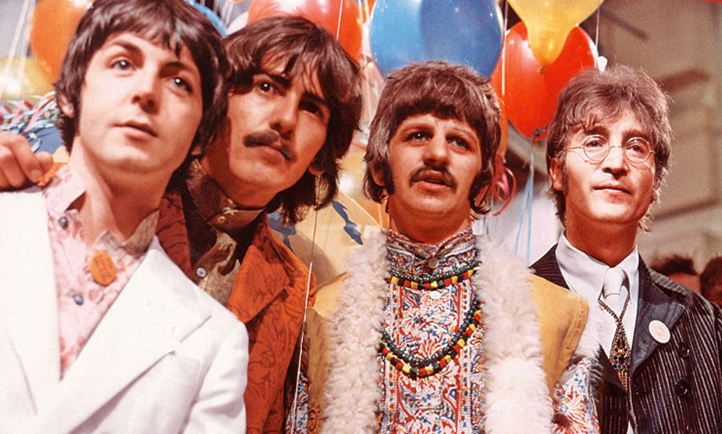
Lennon’s compositions on the album were more experimental than McCartney’s. “Lucy In the Sky with Diamonds” was inspired by a drawing that his young son made in nursery school. The song modulates between musical keys, with Lennon singing a monotone verse over an increasingly complicated underlying arrangement featuring Harrison’s tambura and a counter-melody organ played by McCartney. Although the song has long been associated with “LSD”, the Beatles firmly deny that was ever the intent in this case while openly admitting that drugs influenced other songs. “Being for the Benefit of Mr. Kite!” contained lyrics which were lifted from an old poster, nearly verbatim. Musically, Lennon wanted a strong carnival atmosphere and this was accomplished by using tape loops from the Abbey Road library, several odd instruments, including a real steam organ and a big bass harmonica, influenced by the sounds on the Beach Boys’ Pet Sounds album. On the sarcastic “Good Morning Good Morning”, Lennon did a sonic version of Andy Warhol’s pop art by lifting themes and phrases from television commercials and shows and adding a sequence of animal sounds to the end, with each successive animal being capable of devouring the one before.
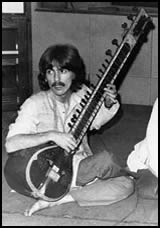 Aside from the aforementioned songs excluded for a single release, the only song recorded for Sgt. Pepper’s and not included on the album was Harrison’s “Only a Northern Song”, a protest of the Beatles’ music publishing practice which gave Lennon and McCartney higher royalties to all songs by the band, even those composed by Harrison. With this exclusion, Harrison had only one composition on the album, “Within You Without You”. This song was heavily influenced by the sitar, the virtuoso Ravi Shankar, and Indian music in general. The recording featured several uncredited Indian musicians along with several more session players. Harrison was the only actual Beatle to perform on the song. This was originally written as a 30-minute piece, but was abbreviated to about 5 minutes for the album.
Aside from the aforementioned songs excluded for a single release, the only song recorded for Sgt. Pepper’s and not included on the album was Harrison’s “Only a Northern Song”, a protest of the Beatles’ music publishing practice which gave Lennon and McCartney higher royalties to all songs by the band, even those composed by Harrison. With this exclusion, Harrison had only one composition on the album, “Within You Without You”. This song was heavily influenced by the sitar, the virtuoso Ravi Shankar, and Indian music in general. The recording featured several uncredited Indian musicians along with several more session players. Harrison was the only actual Beatle to perform on the song. This was originally written as a 30-minute piece, but was abbreviated to about 5 minutes for the album.
Although Sgt. Pepper’s Lonely Hearts Club Band was not released until June 1, 1967, recording had wrapped by mid April and the Beatles dove right into writing and recording new material. Some of these sessions proved fruitless, such as an Abbey Road session on May 7th, where the band “jammed” for over seven hours with little committed to tape and no new material to build on. They also spent several sessions working on “You Know My Name (Look Up the Number)”, perhaps the weirdest song in the Beatles collection which is only really interesting because it features a saxophone part by Rolling Stone Brian Jones. This song was not released for nearly 3 years when it became the ‘B’ side for the 1970 single “Let It Be”.
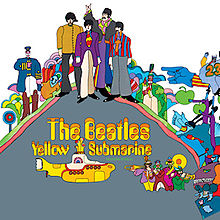 During this time the band also wrote and recorded the bulk of the new material for the upcoming animated film Yellow Submarine (although that soundtrack would not be released until January 1969). Along with “Only a Northern Song”, the soundtrack would include The June 1967 recordings “All Together Now”, which McCartney described as a children’s sing-along in the music hall tradition and “It’s All Too Much”, one of the few Beatles songs to be recorded in a studio outside of Abbey Road. Another song written and recorded during that time for Yellow Submarine was “Baby You’re a Rich Man”, a hybrid of two songs which makes heavy use of the clavioline, an unusual instrument. However, this last song was pushed up for release, first as the ‘B’ side to their next single “All You Need Is Love” and later included on the US version of the album Magical Mystery Tour.
During this time the band also wrote and recorded the bulk of the new material for the upcoming animated film Yellow Submarine (although that soundtrack would not be released until January 1969). Along with “Only a Northern Song”, the soundtrack would include The June 1967 recordings “All Together Now”, which McCartney described as a children’s sing-along in the music hall tradition and “It’s All Too Much”, one of the few Beatles songs to be recorded in a studio outside of Abbey Road. Another song written and recorded during that time for Yellow Submarine was “Baby You’re a Rich Man”, a hybrid of two songs which makes heavy use of the clavioline, an unusual instrument. However, this last song was pushed up for release, first as the ‘B’ side to their next single “All You Need Is Love” and later included on the US version of the album Magical Mystery Tour.
“All You Need Is Love” was written specifically for a worldwide television broadcast called Our World, which was the first ever live global television broadcast on June 25, 1967, and was watched by 400 million people worldwide. The BBC had commissioned The Beatles to write a song as the United Kingdom’s contribution, requesting a song containing a simple message that could be understood by all nationalities. Lennon gladly took up the task and wrote the song in a short time with Martin arranging a live orchestra in the studio for the broadcast with the band accompanied by friends and acquaintances seated on the floor. The result is a simple anthem with the message “nothing else means anything without love”, and the leading indicator for what would be termed the “summer of love”. The single “All You Need Is Love”/”Baby You’re a Rich Man” was released on July 7, 1967 and reached the #1 position in every major country that had a pop chart.
After the live broadcast, the Beatles took much of the rest of the summer off to plan for their next project. In August, all four members of the band traveled to Bangor, Wales to study with Maharishi Mahesh Yogi, who they collectively regarded as their spiritual advisor at the time.  While in Wales, the band received the tragic news that their manager Brian Epstein had died from an accidental drug overdose. Later referred to by band members as “the fifth Beatle”, Epstein had forged the band’s image and shaped their early career through all the madness of “Beatlemania”. After the band ceased touring in 1966, Epstein’s role in the band diminished quickly and he began to display erratic behavior and developed chemical dependency. Many music historians would later pin-point this moment, the moment of Epstein’s death, as setting the ultimate course for the band’s eventual breakup.
While in Wales, the band received the tragic news that their manager Brian Epstein had died from an accidental drug overdose. Later referred to by band members as “the fifth Beatle”, Epstein had forged the band’s image and shaped their early career through all the madness of “Beatlemania”. After the band ceased touring in 1966, Epstein’s role in the band diminished quickly and he began to display erratic behavior and developed chemical dependency. Many music historians would later pin-point this moment, the moment of Epstein’s death, as setting the ultimate course for the band’s eventual breakup.
The band returned to Abbey Road studio on August 22nd to work on material for their next project, a film and score called Magical Mystery Tour. The title came from a song the band recorded back in May, which would serve the same basic purpose as the title song for Sgt. Pepper’s – an introduction for the listener to the adventure they are about to take. This catchy tune contains good effects and production techniques. The songs key lyric, “Roll up, roll up” served the duo purpose of harkening back to the old circus barkers as well as a veiled reference to rolling up a joint. The first song written specifically for Magical Mystery Tour was “Your Mother Should Know”, serving as an old-fashioned dance segment choreographed for the film to the sounds of this song with fine organ interludes. Here McCartney sported a black carnation, different than the rest of the band, which was cited as one of the many clues in the “Paul is dead” conspiracy.
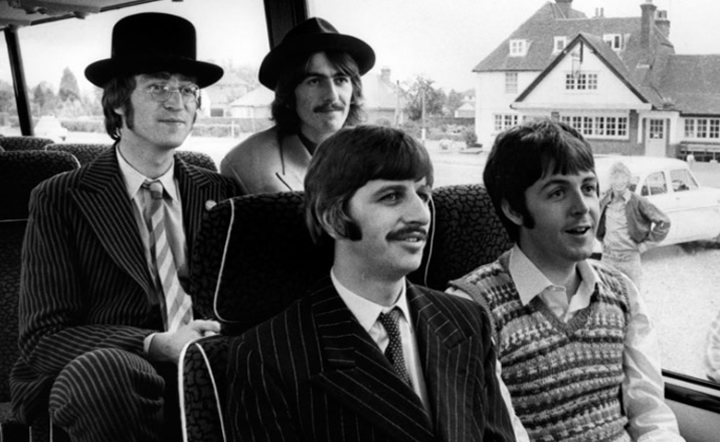
The film was made in September in various English locations which were traveled to by the bus carrying the band and cast members. There was no script, as the emphasis was on the “mystery” of what would happen during the tour. Nothing much did, and the band grew increasingly frustrated by fans who began to trail the band along the way. Still, the band made some very interesting music during the fall of 1967. Included here was the cool instrumental “Flying”, featuring a dual guitar by McCartney and Harrison and a mellotron lead by Lennon. This was the only Beatles song credited to all four members of the band. “The Fool On The Hill” is a fine ballad by McCartney, written during a visit back to his father’s house in Liverpool. Lyrically, the song paints a pictures in the mind and fits in perfectly with the music, mainly performed by McCartney. Harrison’s contribution to the album is the surreal “Blue Jay Way”, with creepy, and literal Lyrics.
Lennon later admitted that “I Am the Walrus” was written during an acid trip. It was a combination of three separate songs that Lennon had been working on, with the Walrus being a reference to a Lewis Carroll poem. Lennon also intentionally wrote the most amusing lyrics he could when he was informed that a teacher at his old high school was deciphering Beatle lyrics in one of his classes and found the the whole process absurd. Musically, the song employs many of the techniques started in Sgt. Pepper’s Lonely Hearts Club Band, with orchestral parts laid on top of a driving electric piano and some fine drumming by Starr.
 The band wrote and recorded “Hello Goodbye” as their next single. Lyrically, the song derived from a songwriting demonstration that McCartney gave when he asked the participant to shout out the opposite of what he sang. Musically, it is a throwback to the mop-top pop days of the band, with some fine overdubs of electric guitar and viola. The song reprises with a coda which came about spontaneously in the studio. The single was released in late November and reached #1 in 10 countries.
The band wrote and recorded “Hello Goodbye” as their next single. Lyrically, the song derived from a songwriting demonstration that McCartney gave when he asked the participant to shout out the opposite of what he sang. Musically, it is a throwback to the mop-top pop days of the band, with some fine overdubs of electric guitar and viola. The song reprises with a coda which came about spontaneously in the studio. The single was released in late November and reached #1 in 10 countries.
Magical Mystery Tour was released on December 8, 1967 as a six song double EP in the UK, featuring only the songs recorded specifically for the film. In the US, these songs were combined with the five songs released on singles earlier in the year – “Strawberry Fields Forever”, “Penny Lane”, “All You Need is Love”, “Baby You’re a Rich Man”, and “Hello, Goodbye” – in order to make a full LP, which was later adapted as the official version of the album. Although the album hasn’t received the same critical acclaim as its predecessor, Sgt. Pepper’s Lonely Hearts Club Band, the album is of similar quality when weighted with the quality singles. On December 26th, the Magical Mystery Tour film was screened on the BBC-1 in black and white and promptly savaged by critics, which may have soured some to the fine music of the album.
The Beatles would continue with a few more years of top quality output prior to their breakup in April 1970. However, they would not again reach the phenomenal level they achieved in 1967.
~
Part of Classic Rock Review’s celebration of 1967 albums.







May 1, 2017 @ 1:38 pm
Excellent recap of the Beatles best year of music (although 1969 is a strong second).
August 7, 2017 @ 7:19 am
the best
Top 9 Album Closing Songs | River of Rock
August 22, 2017 @ 5:55 pm
[…] crowning jewel of Sgt. Pepper’s Lonely Hearts Club Band Fuses separate compositions by John Lennon and Paul McCartney into a singular masterpiece. Starting […]
Ned Rorem – The Music of the Beatles, în NYRB, ianuarie 1968 | @ntonesei's blog
March 14, 2018 @ 11:47 am
[…] https://classicrockreview.com/2012/08/1967-beatles-albums/ […]
The Beatles in India | River of Rock
April 3, 2020 @ 8:41 pm
[…] trip followed the adventurous and tumultuous year of 1967. That year was the group’s first full year without touring, where they produced and recorded […]
The Beatles in India | Classic Rock Review
October 21, 2020 @ 9:57 am
[…] trip followed the adventurous and tumultuous year of 1967. That year was the group’s first full year without touring, where they produced and recorded […]
January 28, 2024 @ 9:27 pm
1967 was definitely Lennon’s best year for songwriting!